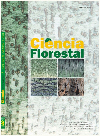
|
Ciência Florestal
Centro de Pesquisas Florestais - CEPEF, Departamento de Ciências Florestais - DCFL, Programa de Pós Graduação em Engenharia Florestal - PPGEF
ISSN: 0103-9954
EISSN: 0103-9954
Vol. 23, No. 1, 2013, pp. 1-17
|
 Bioline Code: cf13001
Bioline Code: cf13001
Full paper language: English
Document type: Research Article
Document available free of charge
|
|
|
Ciência Florestal, Vol. 23, No. 1, 2013, pp. 1-17
| en |
CONSERVATION OF THE FORESTS AT BENFICA SETTLEMENT PROJECT IN SOUTHEASTERN AMAZON
Coelho, Roberta de Fátima Rodrigues; Miranda, Izildinha de Souza & Mitja, Danielle
Abstract
In this study we analyze the floristic and structure of forest remnants in Benfica Settlement Project located
in the municipality of Itupiranga, in southeastern Amazon. Eleven areas of forests located in different
properties and different levels of disturbance were selected. Within each area, plants in one plot of 500 m2,
were surveyed considering three strata: upper, middle and inferior. The species were classified in five life
forms: tree, scrub, liana, palm and herb; and two functional groups, the pioneer and forest species. Two
houndred and eighty-six (286) species, 173 genera and 68 families were found. Most woody species (51 %)
occurred in only one stratum. The richness of species was 70 % of estimated richness by Jack-nife of first
order. The percentage of rare species was high, 138 species occurred in only one area. In all strata, the trees
had higher density, except in inferior stratum, where the grasses were denser. The forest species, in all strata,
were dominant. There was significant difference between the forest and pioneer in all forms of life, in all
strata. The principal components analysis showed heterogeneity among the studied plots, forming three
groups which appear to be related to the different disturbance levels.
Keywords
life forms; functional groups; richness
|
| |
| pt |
CONSERVAÇÃO DAS FLORESTAS DO PROJETO DE ASSENTAMENTO BENFICA, SUDESTE DA AMAZÔNIA
Coelho, Roberta de Fátima Rodrigues; Miranda, Izildinha de Souza & Mitja, Danielle
Resumo
Este trabalho teve como objetivo descrever e analisar a composição florística e a estrutura de remanescentes
florestais do Projeto de Assentamento Benfica, no município de Itupiranga, Pará. Foram selecionadas 11
áreas de florestas localizadas em diferentes propriedades e com diferentes níveis de perturbação. No interior
de cada área foi inventariada a vegetação em um transecto de 500 m2, considerando três estratos: superior,
médio e inferior. A vegetação foi classificada em cinco formas de vida: árvores, arbustos, lianas, palmeiras
e herbáceas; e dois grupos funcionais: pioneiras e florestais. Foram encontradas 286 espécies, 173 gêneros
e 68 famílias. A maioria das espécies lenhosas (51 %) ocorreu em apenas um estrato. A riqueza de espécies
correspondeu a 70 % da riqueza estimada por Jack-nife de primeira ordem (J1 = 418,45). A porcentagem
de espécies raras foi alta; 138 espécies ocorreram em apenas uma área. Em todos os estratos, as árvores
apresentaram maior densidade, exceto no estrato inferior, onde as herbáceas foram mais densas, seguida
das árvores. As espécies florestais predominaram em todos os estratos. Houve diferença significativa
entre as florestais e pioneiras em todas as formas de vida, em todos os estratos. A análise de componentes
principais mostrou heterogeneidade entre os transectos estudados, formando três grupos que parecem estar
relacionados com os diferentes níveis de perturbações.
Palavras-chave
formas de vida; grupos funcionais; riqueza
|
| |
© Copyright 2013 - Ciência Florestal
Alternative site location: http://cascavel.ufsm.br/revistas/ojs-2.2.2/index.php/cienciaflorestal/index
|
|
